Detroit Tigers: Top 20 prospects for 2022 – Part Two

Welcome to Motor City Bengals’ Top 20 Detroit Tigers Prospects for 2022.
Yesterday we published the first half of our Detroit Tigers Top 20 prospects list, and today we finish with prospects 10 through 1.
If you missed the first list and/or don’t feel like going back to read it, here’s how the process works: Six MCB contributors created independent lists of their top 25 Detroit Tigers prospects, and we averaged those rankings together to get our top 20.
We’ve included a small blurb about each player below the picture, but keep an eye out for upcoming stories on players who just missed our list, as well as detailed profiles on each of the top 20 prospects in the system.
Detroit Tigers No. 10 Prospect – Izaac Pacheco – IF

Izaac Pacheco was Detroit’s third pick in the 2021 MLB Draft (39th overall), and as a fixture on the high-school showcase circuit with a commitment to Texas A&M, he had some extra negotiating power. His $2.75 million bonus was actually the 2nd highest given out by the club, and the 25th highest received by any player in the draft. The early returns on that investment weren’t great, as Pacheco had some strikeout issues, and reportedly struggled against pedestrian pitching. But it’s important not to put too much stock into a high-school hitter’s pro debut, particularly when we’re talking about 125 plate appearances.
Pacheco stands out most for his size and power — he’s 6’4 and weighs 225 lbs. — and he seemingly gets all that mass behind his lefty bat, producing plus-plus raw power in batting practice. Despite his stature, Pacheco is surprisingly agile and athletic on defense, with average speed, solid hands, and a strong arm. He’s a lock to move off shortstop, but if he stays roughly the same size he may be able to provide average defense at third base. There’s a decent chance he outgrows the left side of the infield entirely, though, which places more emphasis on the development of a hit tool that projects to below-average. Pacheco has the right mix of patience and power to be productive even with a lackluster hit tool, but he’ll need to make far more contact in the future. He figures to return to rookie ball next year.
https://twitter.com/Tiger_Lifer/status/1433491576718827526?s=20
Detroit Tigers No. 9 Prospect – Colt Keith – IF

Colt Keith lived an itinerant life as a youth, but his family eventually settled in Mississippi, where he was an award-winning two-way player. Keith threw in the low-90s from the mound and was a legitimate prospect as a pitcher, but the Tigers took him in the 5th round of the 2020 draft because they liked his bat Keith stayed in extended spring training for about a month, but then he managed to hit his way to High-A West Michigan in fewer than 50 games.
Keith developed a bit of a pattern in his first pro season. At each step he was initially a bit too aggressive, but then he would quickly adjust. First he started taking more walks, and then he began to hit the ball with more authority. He hit just .191/.296/.255 in his first 14 games in Low-A, then posted a .380/.480/.500 line over his final 30 contests at the level, and he was seemingly making a similar adjustment in High A when the season ended.
Keith shows average raw power, but his swing is short and relatively flat, leading to a lot of hard grounders and low liners. He spent most of his time at third base last season, but he also saw 17 games at second base. His plus-or-better arm strength jumps out immediately, but his hands aren’t terribly soft, and his movements are a bit stiff. Keith may fit best in right field, in which case he’ll need to add a bit of loft to his swing to produce more in-game power.
https://twitter.com/tigersMLreport/status/1432080902776135684?s=20
Detroit Tigers No. 8 Prospect – Roberto Campos – OF
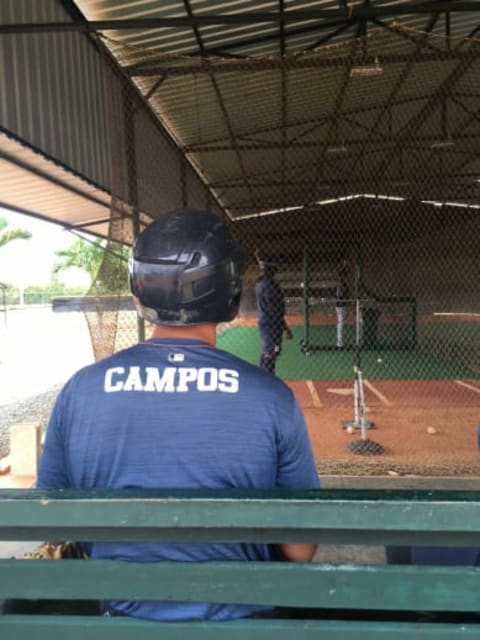
Christian Santana’s $2.95 million bonus set a new Tigers record for international spending, besting Roberto Campos’ $2.85 million bonus from the previous year. But while Santana was a fairly well-known player, Campos was an utter enigma. He defected from Cuba and largely avoided the public eye before the Tigers signed him, so no one really knew what to expect. Then he homered in his first professional at-bat.
Campos is a big, athletic outfielder with plus power potential. He played mostly center field last year, but also spent time in right field, and he’ll likely stick in a corner as he continues to get bigger and stronger. Campos has a chance to produce well above-average power numbers in his prime, but right now he employs a pull-heavy, line-drive approach, and he’ll need to continue to refine his swing to effectively tap into his raw pop at higher levels.
It might be useful to compare Campos to our number 10 prospect, Izaac Pacheco, as they received similar bonuses, and played at the same level in 2021. Campos is about seven months younger, but he struck out significantly less than Pacheco, and hit for much more power. It’s too soon to know if that comparison says anything about either player’s future…but it explains why Campos is two spots ahead of Pacheco on our list.
Roberto Campos is an artist and he admires his work.
— Detroit Tigers Player Development (@RoadtoDetroit) July 10, 2021
We also admire this homer. pic.twitter.com/GomxUYW8Ni
Detroit Tigers No. 7 Prospect – Joey Wentz – LHP

Joey Wentz was the primary return from Atlanta in Detroit’s 2019 deadline trade of Shane Greene, and after a handful of utterly dominant post-trade outings in Double-A Erie (5G, 25.2 IP, 2.10 ERA, 37K, 4BB) it looked as though he was a huge steal. That may still prove true, but Wentz went down with Tommy John surgery in March of 2020, and he wasn’t very crisp or efficient in his return to the mound last year. Wentz stands 6’5, and he’s a solid athlete who showed big-time power potential as a first baseman in high school, but the Braves took him as a pitcher with the 40th pick in the 2016 draft. He was dominant in 2017, but then battled injuries and inconsistency before his excellent run in Erie.
Wentz’s fastball shows fringe-average velocity, siting in the 90-92 MPH range and occasionally touching as high as 95, but it plays up slightly thanks to his arm angle and above-average spin rates. Before surgery, his best pitch was a mid-80s changeup, but he also shows a sweeping low-80s slider, and the occasional mid-70s curve. Wentz struggled to locate all his offerings last year, and had trouble putting hitters away, but for now we consider those fairly typical post-surgery issues. When he’s at his best, Wentz looks like a potential #4 starter, but if he remains the pitcher he was in 2021, he may top out as an emergency starter or long reliever.
Joey Wentz is on the mound in Erie tonight. Here’s his 2nd inning of work, with @Greg_Gania on the call. pic.twitter.com/Ij8ytcvseF
— Tigers Minor League Report (@tigersMLreport) August 31, 2021
Detroit Tigers No. 6 Prospect – Ryan Kreidler – SS/3B

Ryan Kreidler was the most pleasant surprise in the Detroit Tigers system in 2021. He struggled to post a .650 OPS in short-season ball in 2019, and entered the year as something of a glove-first afterthought. But by the end of the season he had shattered the modern record for home runs by a Tigers minor-league shortstop, and he was in Triple A, getting on base more than 40% of the time. Some thought he might be Detroit’s shortstop of the future, and Tigers GM Al Avila said other teams expressed interest in trading for Kreidler.
A 4th-round pick in 2019 out of UCLA, Kreidler was known mostly for his defense in college, but he did flash some power potential when he hit nine home runs as a junior. He showed improved pitch recognition and plate discipline as 2021 wore on, but he still gets fooled by quality breaking balls in the zone, and he projects to be a fringe-average hitter at the MLB level. He has above-average raw power and can go deep to any part of the field, and he’s an average runner who could steal double-digit bases early in his career. On defense Kreidler shows the instincts, range, hands, and arm to play shortstop at the highest level, but he could also be an above-average defender at third base or second base. He’ll likely begin 2022 back in Triple-A, and he gives the Tigers some much-needed infield depth.
https://twitter.com/MudHens/status/1441451592897683456?s=20
Detroit Tigers No. 5 Prospect – Ty Madden – RHP

*College stats
Ty Madden was one of the best, most consistent, and hardest-throwing pitchers in college baseball in 2021, and as such he was ranked a top-12 draft prospect by Baseball America, FanGraphs, and MLB Pipeline. But late concerns about the movement and effectiveness of his fastball led to a draft-day slide, and the Tigers happily scooped him up with the 32nd overall pick. He will be a fascinating pitcher to watch in pro ball.
Madden has an ideal starter’s frame and maintained his quality stuff through a full college season with Texas. He pitches from a high-3/4 arm slot that is nearly straight over the top, and his fastball sits in the mid-90s and touches 99. The pitch works best when he locates it low, as college batters did a lot of damage against his heater when he left it up in the zone. Madden’s money pitch was his mid-80s slider, which shows some mild horizontal movement and drops so much it almost resembles a splitter. He also has an upper-80s changeup, but almost never threw it in college, and he throws plenty of strikes, but enters pro ball with below-average command. It’s easy to envision Madden making a few mechanical tweaks and then flying through the minors to become a mid-rotation starter…but it’s equally easy to imagine him becoming a slider-heavy reliever who has to pitch backward. He’ll likely begin his 2022 season in High-A West Michigan.
another sensational outing for @TexasBaseball RHP Ty Madden, one of the top pitchers in the 2021 Draft
— Céspedes Family BBQ (@CespedesBBQ) March 6, 2021
last week vs. BYU: 7 IP, 1 H, 0 ER, 1 BB, 11 K
tonight vs. Houston: 9 IP, 2 H, 0 ER, 2 BB, 14 K
all 14 strikeouts, for your viewing pleasure: pic.twitter.com/I2CkVbDq3X
Detroit Tigers No. 4 Prospect – Jackson Jobe – RHP
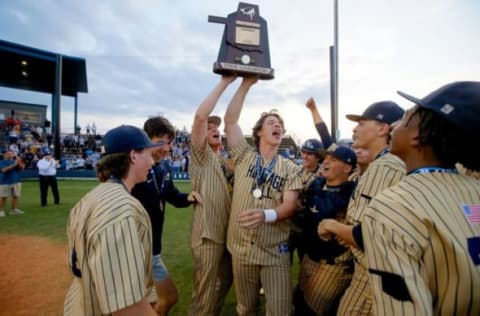
At the beginning of 2020’s summer showcase circuit Jackson Jobe was an intriguing shortstop prospect with power potential and a good arm that let him work as a closer. By the following July, when the Detroit Tigers selected him with the 3rd overall pick, he had developed into one of the best pitching prospects of the last decade. The industry has largely shied away from prep righties in recent years, with good reason, but the Tigers took a shot on a player who arguably had the highest upside in the draft.
There’s an awful lot to like about Jackson Jobe. He’s an above-average athlete who also played quarterback and safety for his high-school football team, and he has athletic bloodlines as the son of a professional golfer. Jobe’s fastball sits in the 92-94 MPH range and hit the upper 90s last spring, and his slider already shows the spin rate and movement of a borderline-elite MLB offering. Scouts also put a future plus grade on his changeup, and think his upper-70s curve has a chance to be above-average as well. He has a relatively simple drop-and-drive delivery that should help him throw strikes and miss bats at the top of the zone. There’s true #1 starter upside here, but Jobe hasn’t thrown a pitch in pro ball yet, and the path forward is filled with obstacles.
Jackson Jobe is a shortstop by trade. I don't think he's a shortstop in scouts' minds anymore. 92-96 w2500 RPM today w/an absolutely devastating slider at 3200 RPMs. Undressed almost every hitter he faced. He'll be on the mound a lot this summer. Huge riser today. #PGNational pic.twitter.com/Tthhs0vwim
— Joe Doyle (@JoeDoyleMiLB) June 18, 2020
Detroit Tigers No. 3 Prospect – Dillon Dingler – C
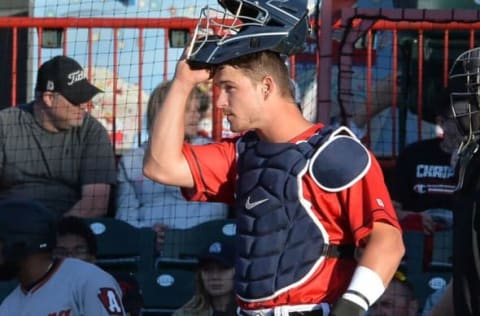
Dillon Dingler’s impressive tools and outstanding start to the 2020 college season earned him some first-round grades, but a lack of high-level experience left him on the board for the Tigers at the top of the 2nd round, and Detroit pounced on the Ohio State backstop with the 38th overall pick. For a few months it looked as though the Tigers nabbed an absolute steal, as Dingler played exceptionally well on both sides of the ball. FanGraphs slid him into their top-100 prospects, and he earned a promotion to Double-A Erie after just 32 games with the West Michigan Whitecaps. He initially seemed unbothered by the step up in competition, hitting .317/.375/.575 in his first 11 games with the SeaWolves. But then his offense absolutely collapsed, and he batted just .170/.231/.245 over his final 39 games in Erie.
Dingler is an aggressive hitter, but when he was on he made consistent hard contact to all fields. He showed plus power to the pull side, with enough juice to go out to center and right, and he’s an above-average athlete who will turn in fringe-average run times to first base. He’s outstanding behind the plate, with athletic actions, a soft glove, and a strong, accurate arm that he loves to use. He can still work on some of the finer aspects of the position, but he has all the tools to be a plus defender at the big-league level. It’s hard to ignore that second-half slide, but Dingler generally looked exhausted by the middle of July, and a broken hand cost him most of August. We don’t think he’s nearly as bad as he performed in the 2nd half of the year, but even if he doesn’t approach what he did in the first half, there’s still a strong chance he becomes a big-league regular on the strength of his defense alone. And if the bat comes back around, the Tigers could have an All-Star on their hands.
And how about Dillon Dingler’s 8th home run of the year? pic.twitter.com/pCsy8HMa2A
— Tigers Minor League Report (@tigersMLreport) June 12, 2021
Detroit Tigers No. 2 Prospect – Spencer Torkelson – 1B
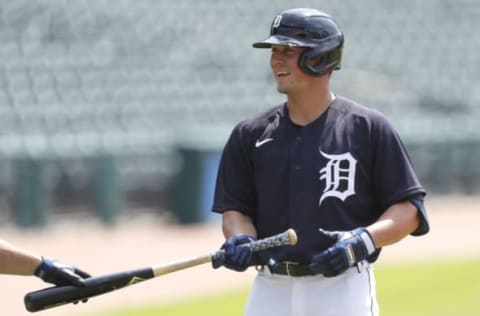
Spencer Torkelson broke all sorts of power-hitting records at Arizona State on the way to becoming one of the most celebrated college hitters of the last few decades, and the Tigers happily selected him with the first overall pick in the 2020 draft. After an ugly spring training performance and a slow start to the season, Torkelson kicked into gear and spent the next four months demolishing minor-league pitching at three different levels. His production dropped slightly every time he rose a level, and we had some questions about his hit tool, but it’s hard to argue with the ultimate results — he was one of just four minor-leaguers to end the year with 30+ home runs and a walk rate above 14%. And then he went to the Arizona Fall League and reached base in 17 of his 28 plate appearances before bowing out with an ankle injury.
There’s little doubt Spencer Torkelson will be a highly productive offensive player in the big leagues. He has 70-grade raw power, and he gets to almost all of it thanks to terrific swing decisions. He rarely chases out of the zone, and will frequently lay off strikes he can’t drive. Pitchers eventually began taking advantage of some of that passivity, and Torkelson could be sequenced into swinging right through pedestrian offerings in the zone. But in the season’s final weeks he began shooting more balls to the opposite field, and that ability to adjust bodes well for his future. Torkelson played third base early in the year, and he was passable there, but his arm was fringy and it’s highly unlikely he’ll ever be the best defensive third baseman on an MLB squad. He should be fine at first base, and he projects to his 30+ home runs on an annual basis.
And there it goes! Spencer Torkelson with a monster blast to left center for his 30th home run of the season. Ties the game, too. pic.twitter.com/Jrxo5LvjYe
— Tigers Minor League Report (@tigersMLreport) October 3, 2021
Detroit Tigers No. 1 Prospect – Riley Greene – OF
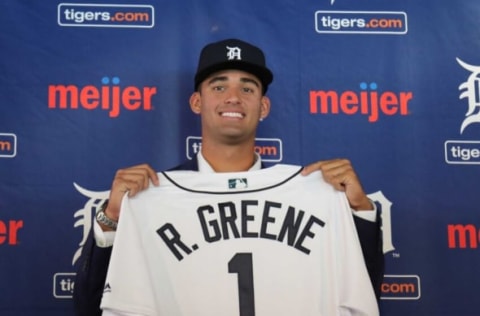
For the second year in a row, Riley Greene is our number one Detroit Tigers prospect. Last year it was a close call, but this time he garnered 5 of our 6 first-place votes. Just 20, Riley Greene hit .300 with 20+ home runs while playing all of his games at Double-A or higher. Only four other players that young have accomplished this since 2006: Vladimir Guerrero Jr., Rafael Devers, Oscar Taveras, and Giancarlo Stanton. And Greene did it after missing an entire season, with just 57 career games under his belt. Greene was terrific through July, hitting .276/.368/.552 in 71 games. Then he went absolutely bonkers, batting .332/.411/.622 over his final 53 games. He also went 16-for-17 on steal attempts, and regularly made spectacular defensive plays in the outfield.
Riley Greene is an outstanding hitter with a rare ability to barrel up the baseball. He hits all kinds of pitches, and all kinds of pitchers, and he swings hard all the time. He did strike out a fair amount last year, and that could be an issue early in his big-league career, but some of that comes from him trying to launch when he gets ahead in counts — he rarely turned down an opportunity to swing 3-0. His raw power nearly rivals that of Spencer Torkelson, and Greene may threaten to hit .300 with 30 home runs in his prime. He has a funky, almost bowlegged stride that belies his slightly above-average speed, and he has proven to be an above-average defender in the outfield thanks to excellent instincts. He may play center field a bit early in his career, but he’ll probably lose a step or two as he ages, and his arm is a bit light, so he likely settles in as a left fielder for the bulk of his career. The solid defense and speed is a plus, but it’s Riley Greene’s bat that could one day have him vying for MVP awards.
Riley Greene’s swing slowed down into poetry. pic.twitter.com/G6VxPzT0QL
— Rogelio Castillo (@rogcastbaseball) July 2, 2021
The Detroit Tigers Holiday Wish List. dark. Next